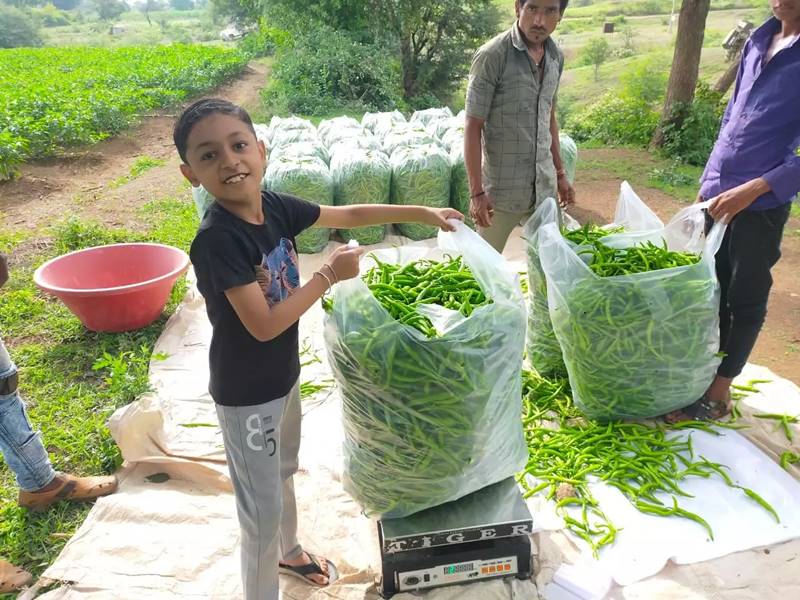Green chilli farmers in the red
The wholesale rate of green chillies is between Rs 15 and Rs 20 a kilo. Consumers pay anything up to Rs 80 a kilo while all that the farmers receive for their efforts is upto Rs 7 a kilo. Chilli farmers feel the burn.


Farmers are not sending anything this time to the mandi because the prices have crashed. All photos: By arrangement
Many districts in Madhya Pradesh have had a bumper crop of green chillies this time, especially in Khargone and Barwani. However, it has left nothing for the farmers to cheer about. “I am not going to harvest the green chillies this time,” Ajay Kag, a green chilly farmer from Rehgun village in Barwani, Madhya Pradesh, told Gaon Connection. “The rate of the chillies in the mandi is so low that I will not even recover my production cost, let alone make any profit,” the 45-year-old farmer, who owns 20 acres (8 hectares) of land and has been growing chillies for eleven years, said.
According to him, it costs him Rs 3-Rs 4 a kilogram (kg) to pick the chillies that will then sell at no more than Rs 3- Rs 6 a kg in the mandi. “Last year, in this season the chillies sold at anything up to fifty five rupees a kg,” Kag added. According to him, 90 per cent of Rehgun village is engaged in cultivating green chillies, which is a cash crop. They grow enough chillies to send several truckloads to the mandi for two weeks at a stretch, but the farmers are not sending anything this time to the mandi because the prices have crashed.
“It costs three hundred rupees a quintal to harvest the chillies. We then spend forty rupees on plastic to pack each quintal. Our cost comes to three hundred and forty rupees while at the mandi, the chillies will sell at no more than three hundred rupees a quintal,” Kag pointed out. The chilli farmers will be wiped out, he added.

Also Read: Healthy Returns: Vegetable and fruit cultivation picks up momentum in India
About 160 kms south of Barwani, is Shirpur in the state of Maharashtra. The area, falling in the Nasik division, is known for its fruit and vegetable cultivation. But the green chillies have lost their bite, even here.
Vicky Rajput who grows green chillies in his seven-acre farm in Shirpur has been sending 20 quintals of green chillies to the mandi every day. But, he is anxious too.
“Nandurbar is more than a hundred kilometres away and I spend four thousand five hundred rupees to transport twenty quintals of green chillies to the mandi there,” the 44-year-old farmer told Gaon Connection.
“So, if I sell my twenty kilos of chillies at fourteen thousand rupees, I have to spend four thousand five hundred rupees to transport it to the mandi. And, after adding my other input costs, I am barely left with anything,” Rajput said.
According to him, last year, the chillies got a good price at the mandis at about Rs 30 to Rs 50 a kg, that is about Rs 3,000 to Rs 5,000 a quintal. Going by last year’s rates, Rajput said he had planted more chillies, but sadly, the market let him down.
Crashing prices
According to the National Horticulture Board, on September 1, this year, in Mumbai’s mandis, green chillies sold at a wholesale rate between Rs 1,500 and Rs 2,000 a quintal. A month before that on August 3, the rate was between Rs 3,000 and Rs 5,000 a quintal. Last year, on September 2, the price of green chillies in the Mumbai mandi was between Rs 3,500 and Rs 4,200 a quintal.

At the Agricultural Produce Market Committee (APMC) in Azadpur, Delhi, on September 9, good quality chillies were sold at Rs 1880-Rs 2,000 a quintal. The previous month on August 3, the chillies sold at Rs 3,000-Rs 4,000 a quintal.
In a posh colony in Lucknow, Uttar Pradesh, the vegetable vendor is selling green chillies at Rs 80 a kg. But in Khargone in Madhya Pradesh, the rate is Rs 40 a kg.
“The chilly crop has had a good yield this year,” PS Barche, rural agriculture development officer, Khargone, told Gaon Connection. There was no disease in the chillies this year, he added.
Also Read: Chillies that were in demand as far as in the Middle East are not even getting the local buyers
“The government should focus on exports. Vegetables are not being able to leave the country with the borders closed, and movement restricted on account of the pandemic,” Sriram Gadhwe, president, Vegetable Growers Association of India, Pune, told Gaon Connection. “We do not see any hope of getting more for our produce,” he said.

Bumper crop
“There has been an increase in the acreage of not just green chillies, but also other vegetables,” Gadhwe said. According to him, adequate rains and enough groundwater has led to more extensive cultivation. However, he said, despite more land coming under cultivation there has not been a corresponding rise in yield. On the other hand the input costs of farmers have risen with more pesticides, and fertilisers being used, he said.
Also Read: On its 93rd Foundation Day, ICAR sums up its contribution to the agriculture sector in the country
Green chillies are in demand right through the year and it is grown across the country. According to the second advance estimate by the Ministry of Agriculture and Farmers Welfare, chilli yield in 2020-21 is expected to be 4392.88 metric tonnes. In 2017-18, India had produced 3,592 metric tonnes of chillies.
The central government had promised that by 2022, it would double the income of farmers in the country. Farmers were urged to grow produce other than wheat or paddy and many schemes came about to help them do that. And the acreage of horticultural crops went up.
However farmers who took up vegetable cultivation are none too pleased with the way things have shaped up.
“I have planted chillies in four acres of land. I know I will not earn any money from them, yet I have to get them harvested,” Suresh Patidar, from Mengaon in Khargone district, Madhya Pradesh, told Gaon Connection. “It means more expenses for me,” he said.
Meanwhile, chilly farmer Ajay Kag from Barwani is wondering how he will make good his Rs 30 lakh investment on the chillies crop. “I owe money to the people from whom I obtained fertilisers and pesticides on credit. How will I pay them,” asked a worried Kag.
Read the story in Hindi.

